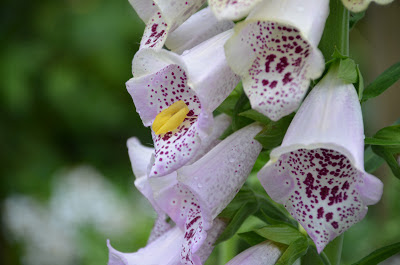When I visited Arundel castle gardens earlier in the year, they were still in the process of designing their brand new stumpery garden. At face value, it looked bleak, somewhat desolate and had a feel of a haunted graveyard rather than a stylised garden.
Of course, other than the upturned tree stumps - impressive as they were - the ground was bare, and only a fool would judge an incomplete design.
 |
| Foxglove blooms |
Fully stocked with a range of herbaceous plants, the planting scheme had completely changed the character of the stumpery garden, giving it a peaceful, mystical feel.
The colour palette was kept muted across the display and so the eyes were not distracted away from the overall fantasy. It would have been tempting to add splashes of colour, but this would have drawn away from the overall impact. That being said, rather than being the main attraction, the upturned stumps had now become a wonderful backdrop worthy of a such a fanciful design. Well done to the gardeners.
So, just what is a stumpery?
 |
| Spring stumpery |
The first stumpery was built in 1856 at Biddulph Grange and they remained popular in Victorian Britain.
The pieces are arranged artistically and plants, typically ferns, mosses and lichens are encouraged to grow around or on them.
One of the most famous modern stumpery is found at Highgrove House, Gloucestershire. This is the home of Prince Charles, and is considered to be the largest stumpery in Britain. The Prince built the stumpery from sweet chestnut roots, held in place by steel bars, when he first purchased the estate in 1980, and it now provides a home for organically grown ferns, hellebores and hostas.
Understandably, stumperies can sometimes be mistaken for garden rubbish. When Prince Philip first saw his son's stumpery, he remarked: "When are you going to set fire to this lot?".
For related articles click onto:
ELCHE GARDENS - The Huerto del Cura
WHAT IS HOMEOSTASIS
What is a Stumpery?
Why is my Tree Fern Dead?







No comments:
Post a Comment